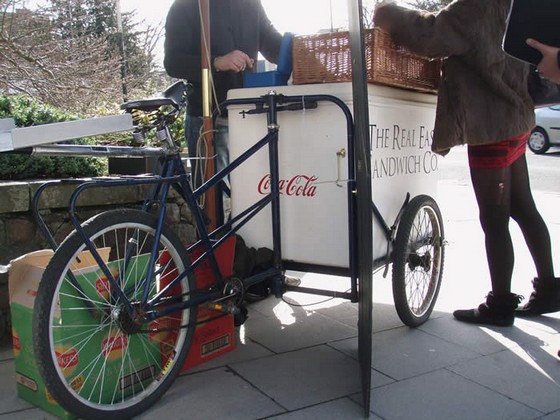|
|
 |
I have come to realize that over the past century, the bicycle has become one of western civilization's bellwether artefacts, indeed it is arguably the artefact that best captures the geography of the modern age. In the nineteenth century it was the first vehicle to offer people the possibility of rapid individual movement, it fathered the automobile industry, and it was for a while one of the defining modern artefacts of material culture - a theme I seek to develop in my book The Ride to Modernity. For much of the twentieth century, in contrast, it has been re-cast as a utilitarian vehicle that forms a part of daily life used to transport people and goods, and continues to be seen in this light in many developing countries (as shown in my recent article on working tricycles in China). But more recently the bicycle has been reinvented again, partly as an environmentally friendly "green" machine in a postmodern world, but for others concerned with speed, status and identity, it has been re-instated as a defining modern artefact carried conspicuously on the back of a sports utility vehicle, and widely used in the media to enhance brands and "perform" other products. It has become a major commodity in international trade (see my recent articles on global Sloanism and global production networks) with sophisticated supply systems and is a product around which major trade fairs have been established.
THE RIDE TO MODERNITY: THE BICYCLE IN CANADA 1869-1900 - published in 2001 by the University of Toronto Press (288pp) Copies of this book (which has over 100 illustrations) may be ordered at most book stores, or from the University of Toronto Press. Failing this, please contact the author at gnorclif@yorku.ca
THE COUNTY BICYCLE SHOP: CATALOGUE OF AN EXHIBITION OF BICYCLES AND TRICYCLES PREPARED BY THE BRUCE COUNTY MUSEUM AND ARCHIVES. This exhibition has toured several county museums in Ontario and used quite extensively in local schools education programs: Bruce County Museum in Southampton: Wellington County Museum in Fergus: Fieldcote Museum in Ancaster: and the McLaughlin Museum, Oshawa. Copies of the Catalogue may be obtained from the author at gnorclif@yorku.ca. This exhibition is addressed to schools programmes and the general public. It examines the role of bicycles and tricycles in the evolution of transportation technology.
VICTORIAN CYCLING. This exhibition was prepared in conjunction with the Royal Ontario Musuem and displayed at Pearson International Airport March - June 2006.
SOME RECENT PAPERS ON CYCLING
- Glen Norcliffe (2005): “The rise of the Coventry bicycle industry 1869-1880, and the geographical construction of technology”, in R. Van der Plas (editor), Cycle History: Proceedings of the Fifteenth International Cycle History Conference (San Francisco: Cycle Publishing) pp.41-58.
-
Philip Mackintosh and Glen Norcliffe (2006): “Flâneurie on bicycles: acquiescence to women in public in the 1890s,” Canadian Geographer, Vol. 50, pp.17-37.
-
Glen Norcliffe (2006): “Associations, modernity and the insider-citizens of a Victorian highwheel bicycle club”. Journal of Historical Sociology, Vol. 19, 121-150.
-
Philip Mackintosh and Glen Norcliffe (2007) : “Men, women and the bicycle: gender and social geography of cycling in the late nineteenth century”, in D. Horton, P. Rosen and P Cox (eds) Cycling and Society (Abingdon: Ashgate Publishing) pp.153-177.
-
Glen Norcliffe (2009): “The Coventry tricycle: technology, gender and buzz”, Cycle History19: Proceedings of the Nineteenth International Cycle History Conference (St.Etienne: Musee d’Arts et d’Industries) pp. 136-143.
-
Glen Norcliffe (2011): Neoliberal mobility and its discontents: working tricycles in China’s cities. City, Culture and Society, Vol. 2(4), 235-242.
- Boyang Gao, Weidong Liu, Glen Norcliffe, and Chao Du (2011) “Trade barriers and global production networks: a study of bicycle trade between China and Canada.” Acta Geographica Sinica, 66(4): 477-486.
- Boyang Gao, Weidong Liu and Glen Norcliffe (2012): Hypermobility and the governance of global production networks: the case of the Canadian cycle industry and its links with China and Taiwan. The Canadian Geographer, Vol. 56,
- Glen Norcliffe (2012): “Before geography? Early tricycles in the age of mecanicians.” Cycle History 21: Proceedings of the Twenty-First International Cycle History Conference (Centre National des Arts et Metiers, Paris, France).
- Glen Norcliffe and Ron Miller (2013): “Defining the nation: the rise of the Canadian Wheelmen.” Cycle History 23: Proceedings of the Twenty-Third International Cycle History Conference (Roeselare, Belgium).
-
Michael Andreae, Jinn-yuh Hsu and Glen Norcliffe (2013): “Performing the trade show: the case of the Taipei International Cycle Show”. Geoforum, Vol. 49(1), 193-201.
-
Glen Norcliffe (2017): “National identity, club citizenship and the formation of the Canadian Wheelman’s Association 1883-87.” Journal of Canadian Studies, Vol. 51(2)461-484.
-
Glen Norcliffe (2016): “Geographical imaginaries in Richard Lesclide’s ‘Le Tour du Monde en Vélocipède’.” Cycle History 26: Proceedings of the Twenty-Sixth International Cycle History Conference (Quorum, Cheltenham) pp.71-75.
-
Glen Norcliffe and Gao Boyang (2018): “Hurry-slow: automobility in Beijing or a resurrection of the kingdom of bicycles?” in Philip Gordon Mackintosh, Richard Dennis and Deryck W. Holdsworth eds. Architectures of Hurry: Mobilities, Cities and Modernity. London: Routledge, pp. 83-99.
-
Glen Norcliffe (2018): “Women and cycling: a revisionist interpretation.” In Cycle History 28: Proceedings of the Twenty-Eighth International Cycle History Conference edited by Gary Sanderson (San Francisco: Cycle Publishing) pp. 86-89.
CRITICAL GEOGRAPHIES OF CYCLING: HISTORY, POLITICAL ECONOMY AND CULTURE
- This new book was published by Routledge in June 2016. Some chapters are new, others are revised versions of papers previously published. The chapters are titled as follows:
- For a geography of cycling.
- GCOT: The geographical construction of technology.
- The AHA! myth: geographically embedded innovation in the Canadian cycle industry 1868-1900.
- Popeism and Fordism: examining the roots of mass production.
- Hypermobile global production networks: links of the Canadian cycle industry with China and Taiwan.
- Associations, modernity and club citizenship in a Victorian highwheel cycle club.
- Men women and the bicycle in the late nineteenth century.
- "Thirty thousand wheelmen who never smile": national identity and the rise of the Canadian Wheelman's Association.
- Performing the bicycle trade show.
- Neoliberal mobility and its discontents: working tricycles in China's cities.
- Right to the road.


|





